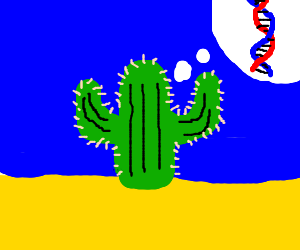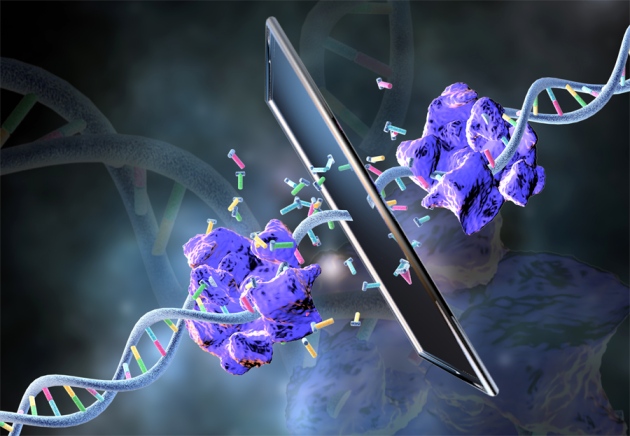Boland and Cinti's flask menagerie: Hair-growing cacti, Martian roses, and living mirrors

A succulent growing human hair in Howard Boland and Laura Cinti’s Cactus Project is an inquiry into primate/plant interrelations, indirectly following up on (by inverting) Whitman’s vision of a poet’s body as an overgrown swamp or canebrake. Bio-art can now perform horizontal gene transfers across species lines, and so Thoreau’s desire to be “the corn and the grass and the atmosphere writing” can also be partially realized in experiments that test the boundaries between humans and their often unruly crops.

A cactus growing human tresses instead of spines suggests (in agreement with Gnostic poets like Gerrit Lansing and Robert Duncan) that most of the items of nature are versions of root and branch, constellating out, in, and slantways in a near-universal grammar of sprouting and probing. John Cage once played a cactus with a contact microphone (with a plucked spine as a plectrum and the cactus’s body as a lyre), but bio-art can “play” on cacti more deeply with the invasive tools of genetic manipulation, inserting human keratin genes into a desert plant’s genome. Such transgenesis, with its imposition of a cross-species trait into a phallic cactus, is both eerily erotic and ominously asexual at once.
Boland and Cinti, proprietors of the UK studio/collective C-Lab, engage in “bio-matter mobilized to perform novel behaviors.” Instead of implanting poetic phrases inside the code of a molecule, they script one-act existential puns in which an organism is given a new and illuminating task. Their Martian Rose exposes its title flower to a simulated Martian atmosphere: a plant associated with romantic ardor figuratively transplanted to a planet named for the Roman god of war. In their mission statement for the MutaMorphosis conference, they refer to Martian Rose as a matter of “poetic imagery” subjected to “harsh conditions.” The “rose,” its name a potential pun on “arisen,” is here a study in genetic compression, hunkering down and abbreviating itself in an effort to withstand the foreign grammar of an alien ambience.

This project seeks to turn a genetically modified rose into a metablossom that sacrifices its sentimental appeal for a more survivalist stress resistance, foregoing its ornamental aspects for an extremophile’s endurance. The rose, long an object of genetic engineering (and poetic imagism), is now a test case to trouble the liminal areas between life and non-life. When this organism was exposed to replicated Mars conditions in a bio-chamber, it crystallized into a kind of cryogenic hibernation so deep it now refuses to be metabolically resurrected. In response, Boland and Cinti plan to concoct a more responsive, reflexive flower that will grow and self-monitor so tactically it can survive extraterrestrial conditions and still merit the name “rose.” This experiment is not only a study in xenotransplanted botany but also a meditation on some of the limits of transformed Being and continued Selfhood.
These environmental and ontological concerns have also moved Boland and Cinti to look into the “reflections” cast by humans onto the microbial world. In their Living Mirror project, the lines formed by magnetic bacteria (which travel vertically along the meridians of our planet’s polarity) can be altered to create a “shimmer” of bio-pixels when disrupted by a human shadow, forming a “liquid mirror” that creates 3D portraits via these bacteria’s response to a human intrusion into their magnetic field. The mirror uses an elaborate network of coils and monitors to project this scattering of microbes onto a liquid medium, quite suitable since primal water is the interface linking humans (whose genome is ninety percent bacterial genes) and microbes into a collective super-being. As well, using the responses of small, living organisms as a billowing mirror of human motion illustrates quite keenly the environmental ripples sent out by the smallest of human gestures.

Bio-poets like Boland and Cinti use rational scientific procedure to giddy and ludic ends, “effing the ineffable” in a currently bandied phrase. They claim that there are organisms being produced as a matter of daily routine in genetic laboratories “far more radical than the ideas of the surrealist movement,” living objects that grapple with their own emergence into subjecthood, born not of surrealist dream logic but of an ontologically punning, near-parodic intensification of laboratory procedures.
Boland discusses “drilling into inherited materials” and dissolving the lines between Artifice and Organism by programming molecules via mutant gene writing. He has been ejected from invited appearances for toting equipment bearing too many biohazard symbols, a sure (if unsettling) signal that his art is testing certain fringes of environmental as well aesthetic sensibility, via gestures that are bio-invasive and bio-enriching by alternating (and occasionally overlapping) turns. In similarly subversive work, Cinti’s primary focus in recent years has been on plant sentience, exploring (via nanoprobes) the varieties of awareness possessed by our vegetable cousins. This research subverts the pathetic fallacy of traditional verse by rerouting it, not imposing human attributes onto plants but uncovering common modes of perception and behavior shared at every level of organic life.
A p.s. to Genesis: notes on transgenic/bio-poetic art